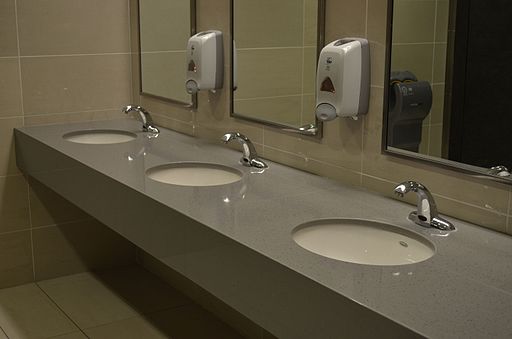This article was first published by Greater GreaterWashington (GGWash.org) on March 17.
In the past year of the pandemic, we have seen many businesses, institutions, and parks shut their restrooms. Many have noted this inconvenience. However, the impact of these closures on our movements has not been equally distributed. People who depend on public restrooms — including essential workers, people experiencing homelessness, and people with disabilities — have been especially impacted. And this lack of access can have long-term consequences.
Can essential workers have their essential needs met?
Essential workers have been heralded as heroes through the pandemic, but they often have trouble accessing restroom facilities. Businesses often do not allow delivery workers or even customers into their restrooms. Many workers, especially gig workers, also are not given time to take bathroom breaks during their shifts. Taking their time can affect their future work, which is linked to delivery time.
Meanwhile, bus drivers and other transport workers often have to drive different routes with less reliable bathroom access than before. And, of course, many restrooms have capacity limitations — which reduces the number of toilets and sinks available at all. What is a worker to do?
Many resort to memorizing where bathrooms can reliably be accessed. A friend who has occasionally done gig work regaled me with stories of urinating into a bottle during their work shift. “I felt super-duper gross,” they said. If Reddit threads, social media, and other stories readily available online are any indication, these issues and experiences are common, as they are around the country.
Some people cannot wait to go home – if they have a home
Many people who have needed a restroom have been told to “hold it in until they get home.” But what if you do not have a home? Many people in Greater Washington and beyond who rely on public restrooms are unhoused. When bathrooms closed, many lost access to basic sanitation — adding yet another trauma to the daily injustices people experiencing homelessness face. Despite efforts by the D.C. government to provide facilities, the lack of access is still a challenge. Furthermore, many new public restrooms or restroom policies are designed to keep people experiencing homelessness out — be it through setups that do not allow for washing, customer-only policies, or police presence at places with restrooms.
The lack of access to restrooms for people experiencing homelessness is connected to various health impacts. The lack of restrooms also keeps many people with homes out of public space. Disabled people and older adults often avoid going out more than is necessary, because of the lack of usable restrooms or fear of not being able to find a bathroom. Many trans and non-binary people also avoid areas where the availability of safe bathrooms is unclear. Each usable, accessible bathroom closed during the pandemic is another barrier to access for someone who needs rapid access to a bathroom or someone who cannot safely use gendered restrooms. Phlush, a restroom availability organization, noted that for economic recovery and public space use to include people, bathrooms need to be accessible.
The impacts go beyond COVID-19
Repeatedly waiting to use a restroom for a long time is not just a temporary inconvenience — it can have serious health impacts. Waiting to use the bathroom can weaken the bladder wall, leading to long-term incontinence and a higher risk of urinary tract infections. Similarly, holding feces in can lead to digestive tract problems and incontinence.
The inability to wash one’s hands puts one at greater risk not only of COVID-19, but for food-borne and water-borne illnesses and bacteria, which can be fatal. So too are the infections and complications that can result from inadequate elimination facilities. People experiencing homelessness often face those risks. And that is before the trauma caused by accidents, the anxiety of waiting to go, and repeated pain and denials of access — not to mention the trauma of bad sanitary conditions for people experiencing homelessness. Recent research has linked a lack of restroom access to risks for suicide for trans and non-binary youth, for example.
One could argue that preventing COVID-19, at all costs, is a noble goal. But as the epidemiologist Dr. Julia Marcus noted, “health is not just the absence of disease.” A society in which people are unable to meet basic needs of elimination safely and with dignity is not a healthy society.
So what can be done?
We can push for WMATA to fully reopen its station restrooms, which have been limited in access since at least 2004. We can also ask local businesses if they will allow delivery workers and other essential workers — especially gig workers — to use their restrooms. We can find ways to incentivize businesses to do so.
We can call on our state legislatures, county and city councils, and our members of Congress to mandate restroom provisions for essential workers, expand sanitation access for people experiencing homelessness, and expand facilities that are accessible for everyone.
We can advocate for parks and other public facilities to reopen their restrooms, as parks in Montgomery and Prince George’s Counties have already done. And, of course, we should educate our neighbors about why public restrooms are so important. Everyone needs to go sometime, after all.




